Here I need a qualified opinion from the attending gurus please (as much as possible so pls feel free to just go at it. Thx).
I am listening to LX521s right now (with my 12inch sealed bass units). I used a similar driver/XO arrangement in my home brewed OBs:
https://www.diyaudio.com/forums/multi-way/123512-ultimate-baffle-gallery-259.html#post5670164
I actually liked that driver complement better (Visaton AL200 + SS 10F/4424g00) than the SL drivers. So I am thinking of making a BOX speaker to put on top of the LX521 sealed bass. I really love the SS 10F driver and would like to stick with it if at all possible.
My tentative design goals are:
1) box size around 12 x 14 x24 inch (W xD xH)
2) run one (or two) AL200(s) from under 100Hz up to 700Hz,
3. use 10F from 700Hz up to TBD but:
3.1) use the lower distortion 8ohm version (10F/8424) but get the sensitivity back up to 90dB or better?
3.2) increase the max SPL capability so the drivers run low on displacement and distortion at higher volumes?
3.3) increase directivity and "throw" into the room (listening distance is 12-13ft) if possible, so the direct to radiated sound ratio gets better?
3.4) introduce a super tweeter if necessary to prevent comb effects (may have to experiment eventually to see if that is an improvement).
Combing may present less of an issue at this listening distance but should still be addressed within reason and that is why I am asking the questions.
I am thinking so far something like these arrangements:
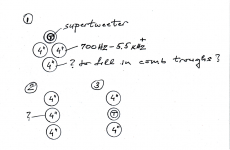
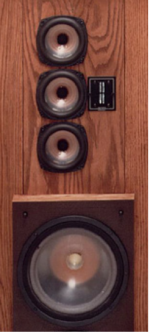
Also, an out-of-the box: if a synergy like upper mid is possible with a cylindrical supertweet in the middle:

Does any of this look doable to you?
Btw I am planning on 3-way active here between AL200, 10Fs and the tbd supertweet, so one EQ per amp channel is available. (actually 4-way with the 12inch sealed sub under).
I am listening to LX521s right now (with my 12inch sealed bass units). I used a similar driver/XO arrangement in my home brewed OBs:
https://www.diyaudio.com/forums/multi-way/123512-ultimate-baffle-gallery-259.html#post5670164
I actually liked that driver complement better (Visaton AL200 + SS 10F/4424g00) than the SL drivers. So I am thinking of making a BOX speaker to put on top of the LX521 sealed bass. I really love the SS 10F driver and would like to stick with it if at all possible.
My tentative design goals are:
1) box size around 12 x 14 x24 inch (W xD xH)
2) run one (or two) AL200(s) from under 100Hz up to 700Hz,
3. use 10F from 700Hz up to TBD but:
3.1) use the lower distortion 8ohm version (10F/8424) but get the sensitivity back up to 90dB or better?
3.2) increase the max SPL capability so the drivers run low on displacement and distortion at higher volumes?
3.3) increase directivity and "throw" into the room (listening distance is 12-13ft) if possible, so the direct to radiated sound ratio gets better?
3.4) introduce a super tweeter if necessary to prevent comb effects (may have to experiment eventually to see if that is an improvement).
Combing may present less of an issue at this listening distance but should still be addressed within reason and that is why I am asking the questions.
I am thinking so far something like these arrangements:


Also, an out-of-the box: if a synergy like upper mid is possible with a cylindrical supertweet in the middle:

Does any of this look doable to you?
Btw I am planning on 3-way active here between AL200, 10Fs and the tbd supertweet, so one EQ per amp channel is available. (actually 4-way with the 12inch sealed sub under).
For the fact that we listen with two ears in a horizontal plane I should probably stay away from the first option (clustered drivers) and stick with vertical (array-like) layouts.
If I use only one AL200 I can get back to 89-90dB/2.83V1m sensitivity on the upper mid by stacking two of the 10F/8424 on top of each other and running them in parallel at 4ohm. If they are super close at 100mm center to center the combing should start at ~3.3Khz and the first big cancellation when the C-C is 2 wavelengths should be at 6.6KHz, right? So, to play it safe I could Low Pass them and add a tweeter on the side from 6KHz and up.
Using more midbass units up to 700Hz (2x AL200 or some other drivers) would get me to probably 93dB/2.83V1m and I see a difficulty getting up there with 3 or 4 of the 10Fs (first impedance- and sensitivity-wise and second: the physical package starts to be a struggle). Unless a synergy like driver could be made. But I figured I would ask for as many opinions as possible before throwing in a towel and settling for less.
If I use only one AL200 I can get back to 89-90dB/2.83V1m sensitivity on the upper mid by stacking two of the 10F/8424 on top of each other and running them in parallel at 4ohm. If they are super close at 100mm center to center the combing should start at ~3.3Khz and the first big cancellation when the C-C is 2 wavelengths should be at 6.6KHz, right? So, to play it safe I could Low Pass them and add a tweeter on the side from 6KHz and up.
Using more midbass units up to 700Hz (2x AL200 or some other drivers) would get me to probably 93dB/2.83V1m and I see a difficulty getting up there with 3 or 4 of the 10Fs (first impedance- and sensitivity-wise and second: the physical package starts to be a struggle). Unless a synergy like driver could be made. But I figured I would ask for as many opinions as possible before throwing in a towel and settling for less.
I know. Mind not made up yet before I know what viable alternatives could be considered. The midbass up to 700Hz will not have any directivity. The SS 10F continues to throw wide up to 5Khz.
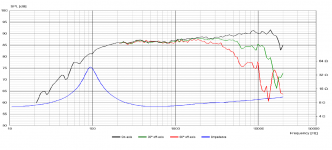
So, in a line array like arrangement the tweeter if added could a be wide dispersing one (e.g. Neo3PDR or similar). However, it would probably be preferred to narrow down the dispersion of 10Fs to match another tweeter at +/-30 (to 45deg max), since that would still throw wide at 12ft listening distance. It all depends on what is feasible and where the upper mid sensitivity ends up since the midbass(es) have to keep up. I thought of the Synergy like arrangement as a risky experiment and I am looking forward to hear from someone who may have taken some measurements with those.

So, in a line array like arrangement the tweeter if added could a be wide dispersing one (e.g. Neo3PDR or similar). However, it would probably be preferred to narrow down the dispersion of 10Fs to match another tweeter at +/-30 (to 45deg max), since that would still throw wide at 12ft listening distance. It all depends on what is feasible and where the upper mid sensitivity ends up since the midbass(es) have to keep up. I thought of the Synergy like arrangement as a risky experiment and I am looking forward to hear from someone who may have taken some measurements with those.
I don't see a question but ideas and conjecture, makes it hard to know what to say.Wow. no more feedback so far. it looks like I raised a tough question?
Since no pros and cons were shared regarding any of the different layouts above, I had to move on and narrow it down.
It turns out that if I pursue an MTM arrangement with two AL200 midbasses, within the height I am ready to consider there is only room for one SS 10F/4424 in between which would be too easy. The intent is to scale up the radiating surface of the upper mid/low tweet and use 2 or 3x SS 10F/8424 (8 ohm version features lower distortion at the same level). So, to package more mid drivers I had to look up another driver to use for midbasses. I chose Beyma 5MP60/N.
>> The key problem is how to combine the multiple mid drivers while ensuring the least compromised sum polar response and to fill in any comb troughs.
I want to use 10F driver as far up in frequency as possible. However, due to combing I am ready to cut back on that range and introduce a super tweeter from say 5.6kHz minimum if needed.
I am currently thinking of passive crossover between the 10F mid number 3 and the supertweet so they can go on one DSP channel/amp. The XO there would be LR2 so the phases and the polar center stay.
The 10F drivers number 1 and 2 would be in series on another DSP channel/amp so they can be LP filtered with maybe a Butterworth instead to get some phase shifting to help fill any combing effects since the XO to tweet is at 2x(10F C-C wavelength). These two drivers would also play at -3dB relative to the number 3 in the center.
This is just off the top of my head, kind of outlining one possible strategy based on some generally available knowledge. This is pretty complicated though. Of course there is always a fallback on something simpler if this turns out not doable with good results; but the idea is to do something new and a bit challenging, which is what this hobby should be all about.
Now I hope I made it specific enough for people to chime in?
The v1 speaker layout with numbered mid drivers is (WxHxD 14x25.375x14 in inches):
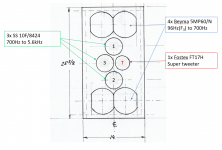
It turns out that if I pursue an MTM arrangement with two AL200 midbasses, within the height I am ready to consider there is only room for one SS 10F/4424 in between which would be too easy. The intent is to scale up the radiating surface of the upper mid/low tweet and use 2 or 3x SS 10F/8424 (8 ohm version features lower distortion at the same level). So, to package more mid drivers I had to look up another driver to use for midbasses. I chose Beyma 5MP60/N.
>> The key problem is how to combine the multiple mid drivers while ensuring the least compromised sum polar response and to fill in any comb troughs.
I want to use 10F driver as far up in frequency as possible. However, due to combing I am ready to cut back on that range and introduce a super tweeter from say 5.6kHz minimum if needed.
I am currently thinking of passive crossover between the 10F mid number 3 and the supertweet so they can go on one DSP channel/amp. The XO there would be LR2 so the phases and the polar center stay.
The 10F drivers number 1 and 2 would be in series on another DSP channel/amp so they can be LP filtered with maybe a Butterworth instead to get some phase shifting to help fill any combing effects since the XO to tweet is at 2x(10F C-C wavelength). These two drivers would also play at -3dB relative to the number 3 in the center.
This is just off the top of my head, kind of outlining one possible strategy based on some generally available knowledge. This is pretty complicated though. Of course there is always a fallback on something simpler if this turns out not doable with good results; but the idea is to do something new and a bit challenging, which is what this hobby should be all about.
Now I hope I made it specific enough for people to chime in?
The v1 speaker layout with numbered mid drivers is (WxHxD 14x25.375x14 in inches):

Last edited:
This drew my attention since here arent many on your side of the pond, that use Visaton drivers.
The AL200 seems like a good driver (as does the GF200) and I have been eye balling them both for what seems like, and probably is, years.
My single largest question would be:
Why stick with the SS 10F if it does not meet sensitivity needs, with a single driver?
Next:
Is an 8", 3", Bullet, a good directivity match?
I.e. wouldn't a 4" mid be a better match? I can think of a couple that have a few more dBs than the 10F, Monacor, Faital pro, and yet have almost rule flat responses
It just seems to be complicating something, that might well sound better, as a simpler implementation.
The AL200 seems like a good driver (as does the GF200) and I have been eye balling them both for what seems like, and probably is, years.
My single largest question would be:
Why stick with the SS 10F if it does not meet sensitivity needs, with a single driver?
Next:
Is an 8", 3", Bullet, a good directivity match?
I.e. wouldn't a 4" mid be a better match? I can think of a couple that have a few more dBs than the 10F, Monacor, Faital pro, and yet have almost rule flat responses
It just seems to be complicating something, that might well sound better, as a simpler implementation.
Yes, this definitely is not a conventional or a "good value" design. Honestly that is the only thing that still really bugs me. It is a paper study until I click on "submit order" for the drivers. The fact that I have an unused pair of AL200 and 10F/4424 at home does not help my decision either; (my OBs finally got kicked out for their low WAF  ). And it is always a struggle to recoup any money when selling diy stuff (average Joe out there only cares about brands).
). And it is always a struggle to recoup any money when selling diy stuff (average Joe out there only cares about brands).
I really love the sound of the 10F driver. For a while I was thinking of making an array with a cheaper driver. However, I listened to everything posted on XRK's subjective blind study of 3 to 5 inch drivers here on the forum, and I still felt the same: 10F gave the most relaxed sound which is the closest to the reference. So I started thinking about how to get that sound on more output. I also wanted MTM which can give a bit of that PA quality in a bigger space, but the 10F driver output is limited. So I ended up here.
As for Visaton: their CSD looks really clean and there is usually some polar response data in the spec sheet. Often they are hard to source here though.
I really love the sound of the 10F driver. For a while I was thinking of making an array with a cheaper driver. However, I listened to everything posted on XRK's subjective blind study of 3 to 5 inch drivers here on the forum, and I still felt the same: 10F gave the most relaxed sound which is the closest to the reference. So I started thinking about how to get that sound on more output. I also wanted MTM which can give a bit of that PA quality in a bigger space, but the 10F driver output is limited. So I ended up here.
As for Visaton: their CSD looks really clean and there is usually some polar response data in the spec sheet. Often they are hard to source here though.
Last edited:
A single 10F should be able to produce about 99dB at it's long term power rating and exceed that for peaks. If the crossover is kept high enough then the distortion is quite low and it could be used over a fairly wide band.
Arrays of any type can get messy and difficult, I understand the idea of scaling up the radiating area of the drivers which arraying does nicely but it comes with the pitfalls of lobing and combing (which can be handled in the system design).
A good way to see the effect of arraying drivers is to use VituixCAD. The achilles heel of any array is the fact that you will have to cross lower to the driver above than you want and that usually meets a tweeter than can cross reasonably low is needed, so a super tweeter to cross high to the 10F won't work in an array.
Arraying the drivers vertically in an expanding MTM type arrangement can work quite well and the relatively small size of the 10F would help in keeping the crossover to the tweeter from becoming unmanageable. To match directivity a waveguide is almost always required.
Making an array taller narrows the vertical directivity meaning that the difference between sitting and standing will be more pronounced. For most people this is not an issue as you sit at the same height but it's something to consider if going that way.
This design is a well done implementation of something like the above.
Heissmann Acoustics | DXT-Wave | d appolito tower speaker
Here is another thread where arraying of drivers is discussed
After a decade of planning, thanks to forum members
Arrays of any type can get messy and difficult, I understand the idea of scaling up the radiating area of the drivers which arraying does nicely but it comes with the pitfalls of lobing and combing (which can be handled in the system design).
A good way to see the effect of arraying drivers is to use VituixCAD. The achilles heel of any array is the fact that you will have to cross lower to the driver above than you want and that usually meets a tweeter than can cross reasonably low is needed, so a super tweeter to cross high to the 10F won't work in an array.
Arraying the drivers vertically in an expanding MTM type arrangement can work quite well and the relatively small size of the 10F would help in keeping the crossover to the tweeter from becoming unmanageable. To match directivity a waveguide is almost always required.
Making an array taller narrows the vertical directivity meaning that the difference between sitting and standing will be more pronounced. For most people this is not an issue as you sit at the same height but it's something to consider if going that way.
This design is a well done implementation of something like the above.
Heissmann Acoustics | DXT-Wave | d appolito tower speaker
Here is another thread where arraying of drivers is discussed
After a decade of planning, thanks to forum members
you rightfully noticed that I am going for a nested MTM arrangement.
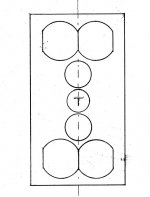
The key difference being that I do not want to cross very low to tweeter so I thought I would make a compound driver in the middle and try to use the other two to fill in where cancellations happen (so almost following in the steps of BeoLab 90 with dedicated DSP on each driver). Thus the more complicated layout in post #10.
The DXT-Wave example you shared seems like a superb execution as far as directivity goes and a nested MTM with conventional XO points; however such a project for me would not feel much different than my previous work on Elsinores:
https://www.diyaudio.com/forums/multi-way/97043-elsinore-project-thread-161.html#post3618366
and I am looking to make a box to stand it up on top of the existing sealed down firing 12inch woofers (thus the height limitation).

The key difference being that I do not want to cross very low to tweeter so I thought I would make a compound driver in the middle and try to use the other two to fill in where cancellations happen (so almost following in the steps of BeoLab 90 with dedicated DSP on each driver). Thus the more complicated layout in post #10.
The DXT-Wave example you shared seems like a superb execution as far as directivity goes and a nested MTM with conventional XO points; however such a project for me would not feel much different than my previous work on Elsinores:
https://www.diyaudio.com/forums/multi-way/97043-elsinore-project-thread-161.html#post3618366
and I am looking to make a box to stand it up on top of the existing sealed down firing 12inch woofers (thus the height limitation).
Last edited:
That is the part that you can't avoid unless you are willing to accept a significant amount of lobing. I can't find much information on the crossover points in the Beolab 90 but I would imagine they are lower than average for a speaker made with the individual drivers singly. Which is something the multiple drivers can handle, much like the Tekton tweeter array.The key difference being that I do not want to cross very low to tweeter so I thought I would make a compound driver in the middle and try to use the other two to fill in where cancellations happen (so almost following in the steps of BeoLab 90 with dedicated DSP on each driver). Thus the more complicated layout in post #10.
More drivers creates bigger distances which needs lower crossover points or accepting more lobing. I would suggest getting familiar with Vituix, you can try out all these combinations based on simulated directivity of the driver sizes or other measured data.
I had a look at Vituix. A cool tool. Designing Xover for on-axis response seems straightforward (I have been using PCD but this tool looks better as far as the optimizer goes). Now designing for off axis and power response with a group of identical drivers should be interesting but there will be a steep learning curve there and it may take me some time. The tool is clearly aimed at passive circuitry design but not sure yet if active (DSP) filters can be applied to simulation. If there is a proficient Vituix user here, please feel free to drop me a PM so I can bug you if I get stuck. Thx in advance.
Last edited:
There is a VituixCAD thread in the software section where the author kimmosto responds.
This video explains the process of creating off axis responses in the diffraction tool, there is a manual which explains most things
Creating off-axis responses with VituixCAD Diffraction tool - YouTube
A little bit of effort will allow you to look at whatever arrangement you want. 2" drivers spaced so a 170mm waveguide will fit in the centre. Cross at 1K steep enough all lobes are avoided. Cross at 2k the 1200Hz will still be in the off axis response.

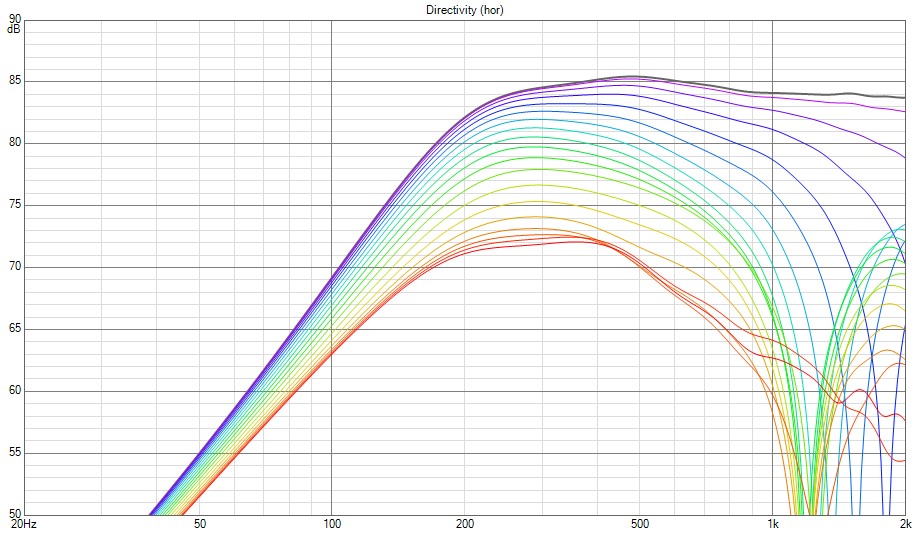
This video explains the process of creating off axis responses in the diffraction tool, there is a manual which explains most things
Creating off-axis responses with VituixCAD Diffraction tool - YouTube
A little bit of effort will allow you to look at whatever arrangement you want. 2" drivers spaced so a 170mm waveguide will fit in the centre. Cross at 1K steep enough all lobes are avoided. Cross at 2k the 1200Hz will still be in the off axis response.
OK, I gave VituixCAD a go. I decided to give up on Beyma midbasses and throw in two Scanspeak 7 inch midbasses (18W8434) instead, at the cost of added height (now it is at the absolute max I can afford with the current downfiring subs on top of which these should go). the other layout with beymas looked better but it does not make sense costwise and the poliprop material may have not been the best match for fiberglass 10Fs used for wide mid range. This way the brand and the cone material are a 100% match between the midbasses and the upper mids.
For the tweeter I also used scanspeak 3/4 inch D2104-712000. Just by using datasheet curves it looks doable. I will probably have to get another tweeter with some directivity though. Fostex FT17H might still be a candidate; however they forgot to put tick marks on the impedance scale in the datasheet so I could not model it properly.
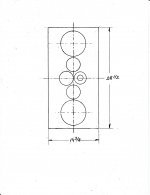
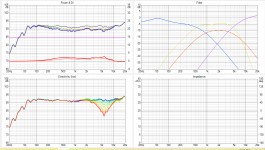
For the tweeter I also used scanspeak 3/4 inch D2104-712000. Just by using datasheet curves it looks doable. I will probably have to get another tweeter with some directivity though. Fostex FT17H might still be a candidate; however they forgot to put tick marks on the impedance scale in the datasheet so I could not model it properly.


Final version with passive XOver between the center 10F mid and the 3/4inch tweeter so that the system is kept 3-way active (plus sub). For the 3-way here I am planning on using the following diy amps, bottom to top: F5, ACA, ACA.
The speaker models very well as wide dispersion throughout; through the upper Xover region only the back radiation shrinks. Phase tracking between the drivers is very good which looks promising for merging their sounds.
All drivers have been attenuated with resistors. I could use a one inch tweeter (D2904) and have the option of further increasing sensitivity but it comes with a bigger flange and some bump above 10Khz. And this is probably enough sensitivity. The bottom and the mid could still be bumped up, though getting a nice slope down is not that easy (tried it).
This is of course a paper study based on manufacturer (ScanSpeak) published frequency responses and impedance. The only way forward now is to make a prototype and take measurements and then refine.
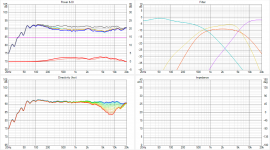
The speaker models very well as wide dispersion throughout; through the upper Xover region only the back radiation shrinks. Phase tracking between the drivers is very good which looks promising for merging their sounds.
All drivers have been attenuated with resistors. I could use a one inch tweeter (D2904) and have the option of further increasing sensitivity but it comes with a bigger flange and some bump above 10Khz. And this is probably enough sensitivity. The bottom and the mid could still be bumped up, though getting a nice slope down is not that easy (tried it).
This is of course a paper study based on manufacturer (ScanSpeak) published frequency responses and impedance. The only way forward now is to make a prototype and take measurements and then refine.

trying to figure out if I can get away with another speaker this big. Mocked it up in cardboard. Even with the width reduced to just 9-1/2 it dwarfs my LX521 OBs; also the down-firing sub unit is too tall to have it at the right listening height. Ideally it should have its own sub right off the floor to lose the added height due to the legs.
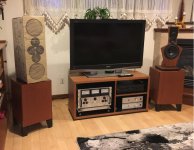
I should probably try to first clear some excess inventory before making anything this big again, but the diy itch as always is relentless...

I should probably try to first clear some excess inventory before making anything this big again, but the diy itch as always is relentless...
Last edited:
- Home
- Loudspeakers
- Multi-Way
- Scaling up a 4inch upper mid and tweet output